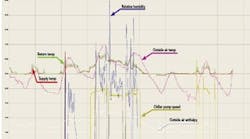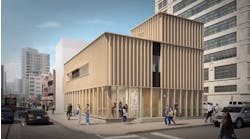If you have an older car but want to go faster, you can invest in a new, high-performance car – or you can learn how to bring out the best performance from your existing car. You can do the same with your HVAC.
Even if your HVAC system is an older “model,” I believe you can increase its performance by 10% to 30%. Most facility managers and plant engineers are satisfied if their system is working as well as it did on its first day. I challenge you to bring your system to a higher level.
Operational efficiency can be boiled down to three concepts: turn it off, don’t heat and then cool, and operate just enough to get the job done by adjusting to conditions. These principles can be applied to most any HVAC system.
A system with mostly fixed setpoints is not going to be very efficient. Computer-controlled systems make the task easier, but even with such tools in place, it may seem like a daunting task to do much optimization. Nevertheless, you can make simple adjustments two to four times per day and see the results in your next utility bill.
My example is a 121,000-square-foot higher education building in Texas. In Texas we still have a need for some cooling in January, unlike parts of the country where chillers can be turned off in the winter and boilers in the summer. The building is supported by two chillers, two boilers, and several air handling units (AHU). Rooms contain one or two thermostats that control terminal boxes supplying hot or cold air. Most of the pumps and the fans for the two cooling towers are controlled with VFDs. Hot water and cold water are pumped to the AHUs’ coils. VFD fans force air over the hot and cold coils to supply the terminal boxes.
To become completely familiar with your HVAC’s operation, you need to chart things like temperatures, pump speeds, and fan speeds. Normally I plot five graphs that track approximately 23 points (see box on last page).
With this information in hand, you’re ready to take the steps toward optimization.
Step 1: Create tight occupancy schedules
The most efficient system is one that is turned off. Consequently, the first step is to schedule rooms tightly. Some control systems will turn on in time to reach the thermostat setpoint at the start of the day. If your system does not, you can observe how long it takes to reach set temperature in typical rooms during each season. Then schedule your heavy equipment accordingly. Work with the IT people to reduce their loads so that you can turn off the AHUs.
Step 2: Adjust the setpoints
Now the fun begins. In a demand response system, the thermostat controlling the terminal box damper drives the response of every piece of equipment up the line. The air handlers, chillers, towers, boilers, and pumps can hang back until the most needy terminal box damper gets to 100% and can no longer maintain its setpoint, forcing adjustment of the AHU setpoint. By increasing the static pressure setpoint, the VFD-driven fan speed will increase to provide more air. If this isn’t sufficient, the setpoint for the cold air is lowered. When the AHU reaches its limit, the pump speed for cold water increases. When the pump gets to 90%, the setpoint on the chiller drops. If your chiller reaches 90%, start running the cooling tower harder.
It’s a simple concept, and it can save thousands of dollars.
Step 3: Program Your Ideas
Assuming you have a computer-controlled building automation system (BAS), you could hire a contractor to design, implement, and maintain the software. Contractors can easily capture the low-hanging fruit, but they can be very expensive. If you want to avoid that cost, you need to train an in-house technician who understands the mechanical system to do the programming.
If programming is too big a step, then you can save by adjusting your setpoints three times a day. For a year, I turned on my home computer when I woke up and set my AHUs, chillers, and pumps to bring the building to a good temperature for the day’s start. At roughly 9 a.m., the peak use would be over, and I lowered my settings for the work day. At quitting time, I set everything back to the minimum. AHU static pressure would go from 1.3 to 0.3 inches. Depending on the humidity, the AHU supply temperature went from 55 to 60 degrees F. This reduced the demand on the chiller, which would slow down until it shut off on cool evenings. The chiller supply temperature was also raised a bit as long as it could maintain the air supply temperatures coming out of the AHUs.
Adjusting setpoints manually resulted in the most dramatic change in my utility costs. However, the challenge with manual adjustment is that people can fail to keep track of all the changes. It takes a lot of time to watch trend lines, generate reports, develop maximum and minimum setpoints over the seasons, and generate strategies to squeeze more out of your system. It’s really a never-ending process similar to flying a small airplane. The pilot continually scans his instrument panel, calculates his remaining fuel, checks his location, checks the weather, and chats with the FAA. A person can run his HVAC system with the same intensity by scanning room temperatures, outside conditions, pump speeds, water temperatures, and schedules.
Goodwill is a potential cost to consider. Testing your latest optimization algorithm may draw unwanted attention from occupants. In this sense, optimizing can be seen as lowering the supplied cooling until the complaints exceed your pain threshold.
A simple beginning for programming can solve a common problem: rooms that have thermostats that fight each other. If not linked, one thermostat can drive to full cold while another drives to heat. Send the setpoint and heat/cool mode to the thermostat in the back of the room to eliminate this problem. Let everyone know that the thermostat next to the door is the only one that should be adjusted. I put a “Dummy” sign on the other one.
Limits While Maintaining Comfort
In addition to acceptable temperature, your system needs to stay within certain limits of CO2 levels and humidity. Let’s review both.
Your system should add enough fresh air to keep the CO2 levels below 1,000 ppm. Above that level, you may get complaints. Bringing in cool outside air is good as long as the humidity can be kept below 60%. You can run higher supply cooling temperatures until you reach your humidity limit.
Monitoring Points for Operational Efficiency
To drive your HVAC to maximum efficiency, you need to recognize the relationships among a variety of system points, including temperatures, pump speeds, and fan speeds. I typically create the following five graphs:
1. Tower
Condensing water supply temperature
Condensing water return temperature
Outside air temperature
Fan speeds for each tower
Outside air enthalpy
Wet bulb temperature
Relative humidity
2. Chiller
Chilled water supply temperature
Chilled water return temperature
Water flow through the chiller
Chiller tons
Full load amps
Kilowatt input
3. Hot water
Hot water return temperature
Supply temperatures for each boiler
Heating tons
Water flow
4. Water meter
Makeup water in gallons
Blow down water in gallons
Domestic water meters
Irrigation water meters
5. Building meters
Kilowatt hours
Cooling tons
Heating tons
Your cooling towers are a variable that can save energy. The chiller likes the lowest possible condensing water supply temperature, and with a VFD-driven fan on your tower, you can evaporate enough water to lower the condensing water to about 2 degrees above wet bulb. Run a test to see how hard you should drive your towers. Step the tower through the wet bulb setpoints of 2, 3, 4, 5, and 6 degrees and record the KWs used by the tower fan and the corresponding KWs by the chiller. Relative humidity and temperature will also affect the optimum setpoint, but if you set your condensing water temperature at 4 degrees above wet bulb, you will be close enough. If your system doesn’t collect enough data to provide wet bulb, set your fans at 80% or do a test to see the benefit at several different humidity levels.
Chilling Out Your Chiller
The chiller is the biggest single consumer of electricity at your site, and it deserves special attention.
You should be able to raise the chiller’s supply temperature as the load goes down. A typical setpoint can be 42 degrees F., and as you raise this point to maybe 50, you can reduce the chiller’s appetite. If you can’t measure the demand conditions, you can do a lot of room temperature monitoring and simply schedule a setback when your building is vacant, making adjustments based on outside air temperature. If you can monitor the cold air damper on your AHUs, vary the setpoint to keep the worst case damper at 90%.
Another variable that you should be able to control is the chilled water pump speed. The VFD probably maintains a differential pressure at the far end of your system. Run a test to determine the KW consumed per BTU supplied and compare that with the cost to lower the water temperature. Typically you will find that you should increase the pump speed to about 90% and then start lowering the chiller supply temperature. You can also write a program that monitors KWs for the chiller and pumps and use the data to minimize the sum of these two power consumers. Since I don’t like to operate anything at over 90% of its capacity, I would still set limits.
It’s not exactly free cooling, but a chiller can provide cool water without running the compressor. By cooling your tower water down to 45 degrees F., the refrigerant can naturally cycle between the condensing and evaporation sides enough to lower the chilled water by a couple of degrees. In my facility’s case, when the chiller cycles off on low supply temperature, the tower fans keep lowering the condensing water past 55 degrees, and all the pumps continue to run. The standby chiller opens all its valves to aid in cooling the chilled water. This operation keeps the chiller off until the outside air temperature rises as high as 60 degrees on a work day. Be sure to bring your condensing water back up to 55 degrees before the chiller starts again.
If you pay for peak electrical use, then controlling the chiller during a startup is critical. Your chiller probably has at least one step. It can limit the maximum full load amps (FLA) to, say, 60% for 20 minutes. Be sure to tell maintenance people not to override it. You can also program the supply setpoint to limit the amps to the last maximum peak load. I’ve found that reducing the chilled water flow to the chiller until the supply temperature is reached is better than letting the pumps run wild until the chiller catches up.
Occasionally your system may need to operate at full capacity to catch up or to provide cooling regardless of the cost. I suggest programming an event. When the EVENT point is on, specific setpoints go to their factory setting. You can also program for an area like a lobby where you want certain pieces of equipment to operate at max, and you want it now. You can then schedule Event A for a specific time.
Is all this fine-tuning worth it? Over a four-year period, I reduced kilowatt hours by an average of 24%. For the air conditioning system alone, the reduction was 37%. Over a five-year period, fine-tuning saved $800,000 in electrical and natural gas charges.
J. Robert Howard is a Facility Manager Administrator, Certified Facility Manager, and LEED AP with degrees in aeronautical engineering and industrial engineering. He has written energy programs in ladder logic, Clipper, and a programming language used by a major controls company. A retired Air Force fighter pilot, he has more than 20 years of experience as a manufacturing engineer and a facility manager. He can be reached at [email protected].


